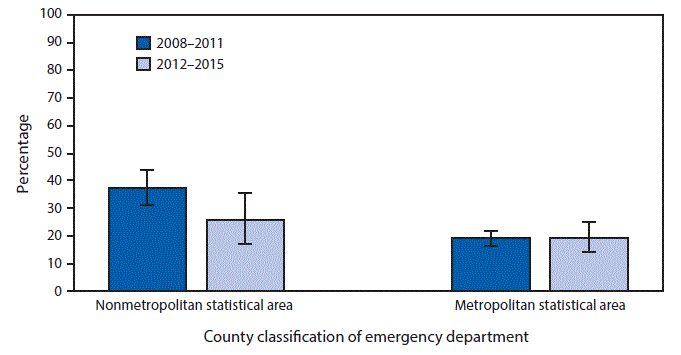QuickStats: Percentage* of Emergency Department Visits for Acute Viral Upper Respiratory Tract Infection† That Had an Antimicrobial Ordered or Prescribed,§ by Metropolitan Statistical Area¶ — United States, 2008–2015**
Weekly / January 26, 2018 / 67(3);111

* With 95% confidence intervals indicated with error bars.
† Acute viral upper respiratory tract infection defined as a visit with only one listed diagnosis and this diagnosis had an International Classification of Diseases, Ninth Revision, Clinical Modification(ICD-9-CM) code for acute nasopharyngitis (ICD-9-CM 460), acute laryngitis and tracheitis (ICD-9-CM 464.xx), acute respiratory infections of multiple or unspecified sites (ICD-9-CM 465.xx), or cough (ICD-9-CM 786.2).
§ Antimicrobial medications included drugs categorized as anti-infectives, derived from Level 1 therapeutic categories from Multum Lexicon Plus.
¶ Metropolitan statistical area definitions are compiled per Office of Management and Budget definitions of core-based statistical areas and are based on the county of the emergency department. Metropolitan statistical area is defined as a core urban area of ≥50,000 population. Nonmetropolitan statistical area is defined as an area of <50,000 population.
** Based on a sample of visits to emergency departments in noninstitutional general and short-stay hospitals, exclusive of Federal, military, and Veterans Administration hospitals, located in 50 states and the District of Columbia.
From 2008–2011 to 2012–2015, the percentage of visits for acute viral upper respiratory tract infection that had an antimicrobial ordered or prescribed decreased from 37.1% to 25.5% among emergency departments (EDs) located in nonmetropolitan statistical areas, but this decline was not seen among EDs in metropolitan statistical areas. In 2008–2011, the percentage was higher among nonmetropolitan EDs than metropolitan EDs, but there was no difference in 2012–2015.
Source: National Center for Health Statistics, National Hospital Ambulatory Medical Care Survey, 2008–2015. https://www.cdc.gov/nchs/ahcd/ahcd_questionnaires.htm.
Reported by: Kari Yacisin, MD, kyacisin@cdc.gov, 301-458-4211; Akintunde Akinseye.






















.png)












No hay comentarios:
Publicar un comentario